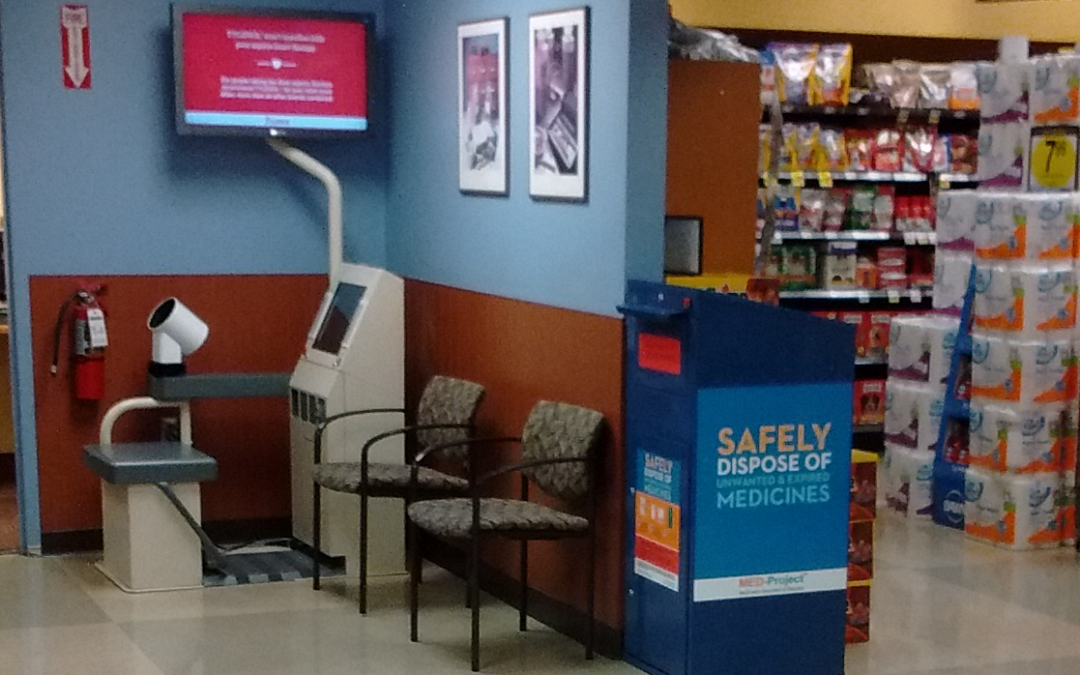When counties in California and Washington state, like Alameda and King, began enacting pharmaceutical stewardship policies several years ago it was out of the compelling need to provide more medicine take-back services to their residents. Now in 2017, the robust and sustainably financed programs envisioned under these local policies are a reality. And the improvement in services for residents is dramatic! More secure medicine drop boxes, in more convenient locations. Prepaid return mailers are provided to home-bound residents and distributed in the community.
These county ordinances are accomplishing the vision of secure medicine take-back under the DEA’s Rule for Disposal of Controlled Substances by shifting drop-off locations from police stations to more convenient drop boxes at pharmacies, clinics, and hospitals.
Why did these counties adopt local drug take-back ordinances? Demand for secure and safe medicine disposal options were overwhelming the resources of local law enforcement, with large amounts of medicines coming in to drop boxes at police stations and collection events. Local resources were limited and unstable, insufficient to provide secure drop boxes in more convenient pharmacy and medical clinic locations. The epidemic of addiction and overdoses from prescription opioids and other medications was continuing to worsen. Local elected leaders listened to community advocates and took action by requiring pharmaceutical manufacturers to provide comprehensive medicine take-back programs.
Here’s a few examples of “before and after” the local pharmaceutical stewardship ordinances:
King County, WA
Before: 10 medicine drop-off sites at law enforcement agencies, but none in the county’s largest cities.
After implementation of a Secure Medicine Return Regulation: 99 secure medicine drop boxes at 75 pharmacies, clinics, or hospitals and 24 law enforcement agencies.
San Francisco, City & County, CA
Before: 10 law enforcement collection sites and 13 pharmacy collection sites that could not accept controlled substances.
After implementation of a Safe Drug Disposal Stewardship Ordinance: 33 secure medicine drop boxes at 21 pharmacies, clinics, or hospitals and 12 law enforcement agencies.
Snohomish County, WA
Before: 25 law enforcement drop boxes and 2 pharmacy drop boxes. Unstable funding for the law enforcement program put its future at risk.
After implementation of a Secure Medicine Return Regulation: 31 secure medicine drop boxes at 18 pharmacies, clinics, or hospitals and 13 law enforcement agencies.
These local ordinances do not restrict other entities from independently operating their own medicine take-back programs. For example, since 2016, Walgreens has provided secure medicine disposal services in a very limited number of its drug stores.
As of November 2017, pharmaceutical manufacturers are financing and coordinating secure medicine return programs in 2 counties in Washington State and 6 counties in California. More county-wide programs will launch in 2017 and 2018 under these local laws. Additional counties are working to pass similar laws, adapting the model policy to their local needs. In Washington State, local Boards of Health in six counties have enacted local ordinances – King, Snohomish, Kitsap, Pierce, Clallam, and Whatcom – covering 60% of the state’s population.
Under these extended producer responsibility (or EPR) policies, drug producers are responsible for financing and coordinating the program, including costs of secure drop boxes, pre-paid mailers, transportation and safe destruction of collected medicines, as well as public education. Qualified drug stores, grocery stores with pharmacies, hospitals/clinics with on-site pharmacies, and law enforcement agencies contribute to the program by staffing and hosting the secure drop boxes. The local agency oversees the drug take-back program for compliance and safety.
A concise summary of the local Secure Medicine Return policy utilized in Washington State is provided in this Summary of the Snohomish Regulation. And depicted in this simple graphic explaining the proposed (now adopted) policy in Whatcom County.
While pharmaceutical manufacturers and their trade associations continue to oppose these local laws, they are complying. More than 400 pharmaceutical companies have formed MED-Project LLC, the stewardship organization that is developing and operating the secure medicine return programs with industry financing. See current MED-Project program locations here: https://med-project.org/locations.
The manufacturers’ MED-Project programs collect prescription drugs, including controlled substances, and over-the-counter medicines (with just a few exceptions for specific exempted drug products). Residents drop all medicines into the secure drop box. No pre-screening by the pharmacist is required. The MED-Project programs follow all security requirements of the DEA’s regulations, as well as other applicable federal and state laws. Most of these local ordinances allow pharmacies, hospitals, and law enforcement agencies to “opt-in” to join the programs over time, therefore the number of secure drop box locations may increase.
With more convenient medicine take-back locations serving the community, messaging to residents about proper disposal of medicines to protect their families and the environment has also improved. Anecdotes from collection sites in WA State are that the drop boxes in pharmacies and grocery stores fill up fast, with MED-Project providing pick-up several times a week in popular locations. MED-Project is required to submit annual reports that provide collection totals, with the first reports anticipated in 2018.
I’ve put together these one-pagers that provide a snapshot of secure medicine return services being provided under county-level pharmaceutical stewardship ordinances.
Secure Medicine Return Programs Operating Under Local Ordinances in WA updated in March 2018
Implementation Status of County Pharmaceutical Stewardship Ordinances (CA, WA, NY) Oct. 2017
See the Pharmaceutical Stewardship Policy section of my Safer Meds page for more information about these local laws. Contact me if your local agency or organization wants to get started on adapting these model policies to your community’s needs.
Post image: a MED-Project drop box in the pharmacy area of a Seattle grocery store.
Photo by Community Environmental Health Strategies LLC.

Recent Comments